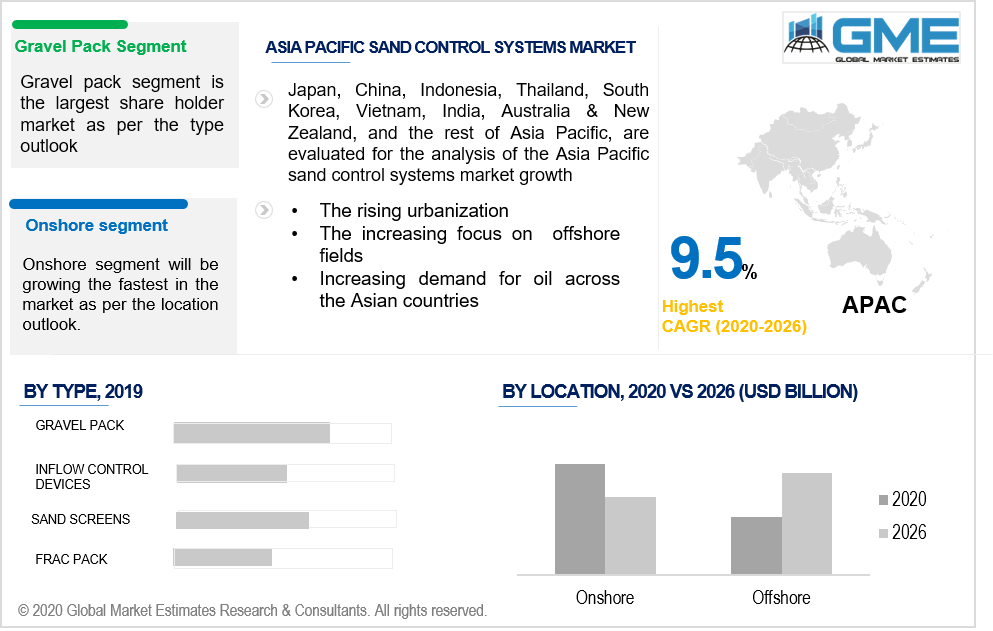
Global Sand Control Solutions Market Size, Trends,and Analysis- Forecasts To 2026 By Well Type (Vertical, Horizontal), By Application (Cased Hole, Open Hole), By Location (Offshore, Onshore), By Type (Frac Pack, Inflow Control Devices, Gravel Pack, Sand Screens, Others), By Region (North America, Asia Pacific, CSA, Europe, and the Middle East and Africa); End-User Landscape, Company Market Share Analysis & Competitor Analysis
Sand control is the management and minimization of sand and particles during the process of oil production.The rising investments in the upstream oil & gas industries and growing demand for oil & natural gas around the globe are anticipated to push market growthduring the forecast period. Also, the growing production of shale gas reserves is expected to speed up the demand for sand control systems. Furthermore, the rising production from mature wells clubbed with the increasing production in deep-water offshore wells has helped the market from 2020 to 2026. However, fluctuation in the oil prices affecting drilling activities is expected to adversely hinder market growth over the estimated timeframe.

Based on the use of this system, the market can be segregated into the cased hole, and open hole. The largest shareholder in the market would be the cased-hole application. Due to technical issues related to the integrity of the cavity, cased-hole sand control methods are more commonly preferred. Also, rising development and exploration activities from unconventional reservoirs have anticipated market growth.
The fragmentation of the market as per the location-based outlook are offshore and onshore fields. The largest market share in 2019 was the onshore oil production fields due to high-capacity onshore reserves.Furthermore, rising demand for onshore applications has indicated an increase in oil production from basins such as the Permian Basin. Hence, these parameters are anticipated to fuel the growth for the onshore sand control solution market throughout the forecast period.
According to the good type, this market can be segregated intotwo segments namely,vertical, and horizontal. The horizontal well type of this market would be the dominating segment as compared to the vertical well type. This is attributed to the rising development ofthe reserves of shale.
Based on the type, this market can be divided into four segments: frac pack, inflow control devices, gravel pack, and sand screens. The gravel pack is anticipated to be the largest shareholder in 2019. Gravel packing is an efficient way to prevent sand formation from entering the development string. Gravel pack systems are being used to increase the surface area of the production well to improve production rates.

Over the expected timeline, the Asia-Pacific region is projected to be the fastest-growing region from 2020-2026. It is anticipated that the growing investment for offshore development and exploration activitiesand will accelerate the development of the region's offshore industry. The rising population of emerging economies has increased demand for energy and thus, increased imports of crude oil. India, China, Japan, and South Korea have imported the region's largest quantity of crude oil, which offers enormous opportunities for market participants in sand control. On the other hand, the market for North America is will be the fastest-growing region mainly due to the growth in the sand formations and the rising development of tight oil.
The major players that compete in this market are Schlumberger, Baker Hughes Company, Superior Energy Services, Anton Oilfield Services, Tendeka, Andmir Group, KattGmbh, Variperm, SiaoPetroleo, Zamam Offshore Services Limited, Sazoil, Halliburton, Weatherford, Oil States International, China Oilfield Services, Rgl Reservoir Management, Middle East Oilfield Services, Mitchell Industries, Shenzhen Max-Well Oilfield Services Ltd., and Kerui Petroleum, among others.
Please note: This is not an exhaustive list of companies profiled in the report.
We value your investment and offer free customization with every report to fulfil your exact research needs.
The Global Sand Control Solutions Market has been studied from the year 2017 till 2026. However, the CAGR provided in the report is from the year 2018 to 2026. The research methodology involved three stages: Desk research, Primary research, and Analysis & Output from the entire research process.

The desk research involved a robust background study which meant referring to paid and unpaid databases to understand the market dynamics; mapping contracts from press releases; identifying the key players in the market, studying their product portfolio, competition level, annual reports/SEC filings & investor presentations; and learning the demand and supply side analysis for the Sand Control Solutions Market .

The primary research activity included telephonic conversations with more than 50 tier 1 industry consultants, distributors, and end-use product manufacturers.

Finally, based on the above thorough research process, an in-depth analysis was carried out considering the following aspects: market attractiveness, current & future market trends, market share analysis, SWOT analysis of the companies and customer analytics.

Tailor made solutions just for you
80% of our clients seek made-to-order reports. How do you want us to tailor yours?
OUR CLIENTS